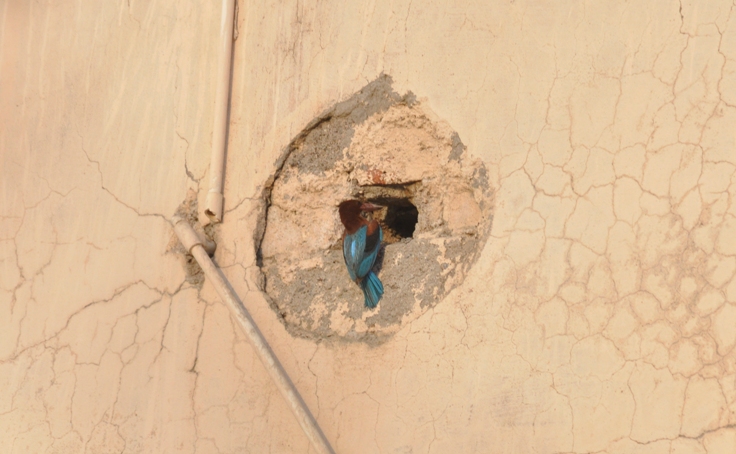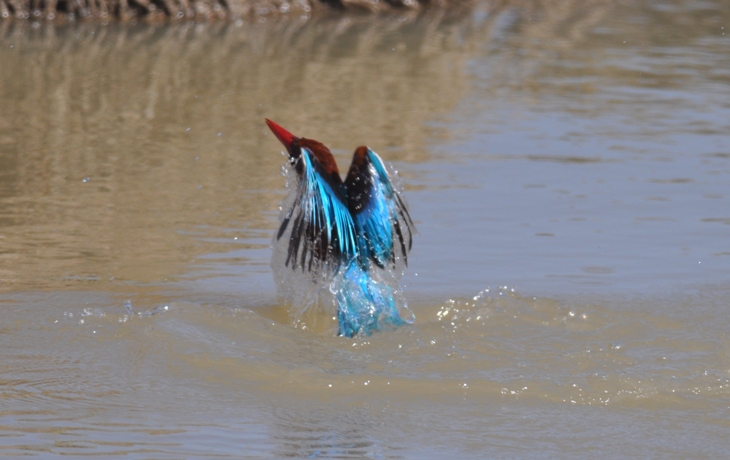A new dimension in White Throated Kingfisher nesting.
By: Ajay Gadikar (Bird Watcher)
In an unusual nesting behaviour, I witnessed a White throated kingfisher (Halcyon symmenis) pair had chosen a makeshift hole of a residential building for its nesting purposes which was in the middle of the town. This typical nesting behaviour was observed
by me in last year near my house. First it was my wife who, while walking in our colony garden, saw the pair calling and moving inside the hole of the building and told me about it.
What seems to be an attempt to adapt with the urban lifestyle and in densely populated area, surrounded by buildings, this pair has chosen to make their nest in a hole left in the wall of a building. I think the hole was left behind after some pipe like
structure was removed and the hole was left as it is and not cemented later. It had turned into a blessing for the kingfisher family as they found a suitable nest cavity to rear their young ones.

We observe their nesting activity for the full season and didn’t try to approach near the nest by any means following the basic birding ethics which quotes that one should not disturb any birds nesting activities. Also there was a huge construction work
going on so we were more alert as the labourers working there would observe our activity and unnecessarily disturb the nest site. We used to visit the place early in the morning and come back before the construction work starts at the site. A makeshift small
water body was present on the construction site. The kingfisher was often seen diving inside the muddy water body in search of any insects and fish. This building will surely disturb the next breeding cycle as the topography of the area will completely change
over the period of next year.

Generally all of the Kingfisher species are known to live near water bodies and rivers but the white throated kingfisher has very well adapted to living in city surroundings where small makeshift water bodies are present. The kingfisher nests are also
very typical and are found near river banks or nallahs. Their nests are horizontal holes dug into the side of an earth cutting or a river bank and are about 3 inches in diameter and often up 1 to 3 feet in length.
Here it had shown a drastically different behaviour. The nest site (east facing) is a hole on 3rd floor of a residential building at a height of nearly 12 meter from ground and amidst other close buildings and with apparently a very small water body present
nearby.
Also in a typical observation I found that though generally this bird nests on the onset of the monsoon but here the bird has stated breeding much before the monsoon.
The male and female were seen for the whole day near the nest site and entering the nest frequently, on continuous observation it was clear that they had laid eggs and were incubating the eggs. Both the sexes were seen performing their parental duties.
We closely saw them bringing different kind of insects and perching for a while near the nest site before entering the hole to feed the young ones inside, also made some videos of the food they used to bring every day. After a few days of observation,
one fine day, we saw a juvenile bird in the vicinity being fed by the adults and we were happy to see that the adult birds have been able to successfully fledge the future generation.
It’s seems that this bird has also adapted to the nest options available near the human settlements and is able to thrive in urban areas.
EXTRA NOTE:
The white throated kingfisher has a very prominent beak adapted to catch fish which is similar to other kingfishers, but has adapted well and is able to survive on different other vertebrates found in city. It feeds on lizards, mice, frogs, dragonflies,
grasshoppers, small perching birds found in the urban areas.